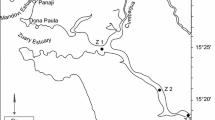Abstract
Grazing by Pseudocalanus minutus on naturally occurring partieles has been investigated over a 2 year period at 5 m depth, in a small coastal embayment in Nova Scotia, Canada. Large variations in the standing stock of particulate matter in the water from 5 m depth were associated with seasonal changes in phytoplankton, and at times with runoff from rivers. Each size group displayed seasonal changes, with high amplitudes occurring in the large-particle size ranges. P. minutus consumption was associated with seasonal changes in total particle concentration as well as with the concentration in each size group. The food uptake was correlated (P>0.01) with the particle concentration in all particle categories, except in the size range below 3.57 μ. Frequency of positive electivity indices increased with particle sizes up to 57 μ and then decreased. Observations on particle spectra revealed considerable seasonal variability in both particle sizes and copepod feeding patterns. P. minutus adapted to seasonal variations within the particle spectrum by shifting its grazing pressure from one size range to another. By taking advantage of every particle peak concentration, P. minutus revealed a strong opportunistic feeding behaviour, and a very efficient utilization of the standing stock. Maximum consumption was recorded in early spring, when P. minutus fed on large-size particles. Feeding took place in the medium and small-size ranges during the summer and part of fall. Food uptake was rarely less than 2.26% of body weight during the winter, and reached up to 55% and sometimes more in spring. The unselective feeding patterus demonstrated by P. minutus suggest certain ecological implications of feeding pressure on standing stock.
Similar content being viewed by others
Literature Cited
Anraku, M. and M. Omori: Preliminary survey of the relationship between the feeding habit and the structure of the mouth parts of marine copepods. Limnol. Oceanogr. 8, 116–126 (1963).
Conover, R. J.: The feeding behaviour and respiration of some marine planktonic crustacea. Biol. Bull. mar. biol. Lab., Woods Hole 119, 399–415 (1960).
—: Feeding on large particles by Calanus hyperboreus (Kroyer). In: Some contemporary studies in marine science, pp 187–194. Ed. by H. Barnes London: Allen & Unwin 1966.
Frost, B. W.: Effects of size and concentration of food particles on the feeding behaviour of the marine planktonic copepod Calanus pacificus. Limnol. Oceanogr. 17, 805–815 (1972).
Harvey, H. W.: Note on the selective feeding by Calanus. J. mar. biol. Ass. U.K. 22, 97–100 (1937).
Ivlev, V. S.: Experimental ecology and nutrition of fishes. Pishchemizdat, Moscow (Transl. by Yale University Press 1961) (1955).
Marshall, S. M. and A. P. Orr: Studies on the biology of Calanus finmarchicus. VIII. Food uptake, assimilation, and excretion in adult and stage V Calanus. J. mar. biol. Ass. U.K. 34, 495–529 (1955).
Mullin, M. M.: Some factors affecting the feeding of marine copepods of the genus Calanus. Limnol. Oceanogr. 8, 239–250 (1963).
—: Selective feeding by calanoid copepods from the Indian Ocean. In: Some contemporary studies in marine science, pp 545–554. Ed. by H. Barnes. London: Allen & Unwin 1966.
Parsons, T. R., R. J. LeBrasseur, and J. D. Fulton: Some observations on the dependence of zooplankton grazing on the cell size and concentration of phytoplankton blooms. J. oceanogr. Soc. Japan 23, 10–17 (1967).
Parsons, T. R. and H. Seki: Importance and general implications of organic matter in aquatic environments In: Organic matter in natural waters, pp 1–27. Ed. by D. W. Hood. College: Institute of Marine Science, University of Alaska 1970.
Poulet, S. A.: Grazing of Pseudocalanus minutus on naturally occurring particulate matter. Limnol. Oceanogr. 18, 564–573 (1973).
Richman, S. and J. N. Rogers: The feeding of Calanus helgolandicus on synchronously growing populations of the marine diatom Ditylum brightwellii. Limnol. Oceanogr. 14, 701–709 (1969).
Roger, C.: Recherches sur la situation trophique d'un groupe d'organismes pélagiques (Euphausiacea). I. Niveaux trophiques des espèces. Mar. Biol. 18, 312–316 (1973).
Sheldon, R. W.: A universal grade scale for particulate materials. Proc. geol. Soc. 1659, 293–295 (1969).
— and T. R. Parsons: A practical manual on the use of the Coulter Counter in marine science, 66 pp. Toronto: Coulter Electronics Inc. 1967.
—, A. Prakash and W. H. Sutcliffe, Jr.: The size distribution of particles in the ocean. Limnol. Oceanogr. 17, 327–340 (1972).
—, W. H. Sutcliffe, Jr. and A Prakash: The production of particles in the surface waters of the ocean with particular reference to the Sargasso Sea. Limnol. Oceanogr. 18, 719–733 (1973).
Sutcliffe, W. H., Jr.: Some relations of land drainage, nutrients, particulate material and fish catch in two eastern Canadian Bays. J. Fish. Res. Bd Can. 29, 357–362 (1972)
Wilson, D. S.: Food size selection among copepods. Ecology 54, 909–914 (1973).
Author information
Authors and Affiliations
Additional information
Communicated by T. R. Parsons, Vancouver
Rights and permissions
About this article
Cite this article
Poulet, S.A. Seasonal grazing of Pseudocalanus minutus on particles. Mar. Biol. 25, 109–123 (1974). https://doi.org/10.1007/BF00389260
Accepted:
Issue Date:
DOI: https://doi.org/10.1007/BF00389260




